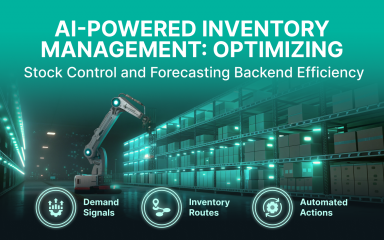Introduction -Why Smart Inventory Is the Next Frontier of eCommerce
Have you ever been devastated by a product that had an available online tag and then received the wretched out of stock email? It is not only bad logistics. It is old-fashioned stocking policy. The modern globalized eCommerce environment is not the place where your stock sits back and twiddles its thumbs, it is the one that is driving customer satisfaction, cash flow and competitive advantage.
AI inventory solutions make previously managed stock lists alive and learning. Rather than waiting to be ordered to reveal shortages, real-time inventory analysis has prediction algorithms that estimate where and when products would flow. You’ll learn how inventory forecasting powered by predictive analytics can anticipate demand shifts before they disrupt your fulfillment process.
The report Succeeding in the AI Supply-Chain Revolution, by McKinsey, shows that the adoption of AI-based forecasting helped companies to reduce inventory by 35 percent, reduce logistics costs by 15 percent and improve service levels by 65 percent. This translates to smarter stocking, faster delivery and less disappointed customers.
AI has also redefined how to do an inventory – automating reconciliations, syncing backend data, and spotting anomalies without human error. One of the industry leaders stated that AI at the backend is not an upgrade but the nervous system of online commerce.
At the conclusion of this article, you will understand why intelligence, not instinct, is transforming every shelf, SKU and supply chain node.
Smarter Inventory Tracking, Forecasting, and Stock Optimization
You may have already experienced the tendency of the errors to multiply in case you have ever used spreadsheets or even some old-fashioned dashboards to monitor inventory. The old system of stock management relies on manual changes, whereas the new system of stock management is an AI system with inventory-tracking tools that provide ongoing information and suggestions. It is not only speed but accuracy. AI is constantly analyzing the buying patterns, warehouse information, and logistics, to ensure that you have the right products in the right place, at the right time and place, when the customers require it.
In simple terms, inventory forecasting uses historical sales, regional trends, and external factors like seasonality to predict demand. With predictive analytics, your system learns to anticipate what sells faster and what stays idle. These even allow the variables of supplier delays, consumer sentiment, and promotional campaigns to be included – making forecasting a data driven dialogue between your sales channels and your warehouses.
Here’s how the transformation looks in practice:
| Feature | Traditional Stock Logs | AI-Powered Inventory Tracking Tool |
| Data Updates | Manual, once daily | Automated, continuous |
| Forecast Accuracy | 60–70% | 90%+ with demand prediction models |
| Cost Efficiency | High holding costs | Optimized reorder points |
| Labor Involvement | Intensive | Minimal |
Gartner estimates that, as of 2028, almost 95 percent of the data-driven decision-making in supply chain operations will be automated via AI, at least partially. Such a change does not only save money but it also creates trust. Customers get what they want and will return when it matches the actual demand.
Your team is also transformed to be proactive as well as reactive by smart stock control software. Your system could automatically order parts when it senses the shortage is about to happen or propose a transfer to the warehouse or reduce advertising on a product that is nearly reaching stock-out. It is not magic – it is AI-optimized math.
With strategic inventory planning, you synchronise replenishment cycles with actual demand, avoiding both costly overstock and missed sales. This is an inventory that uses data to make it an asset rather than a liability, and that it is an intelligent asset, which has the ability to self-optimize itself, and that it is a self-optimizing asset that keeps on optimizing itself.
It is the ability to combine the possibilities of inventory tracking tools with AI predictive and stock management software and gain visibility, speed, and value – it is the ability to change inventory into an active driver of your processes instead of a dead weight.
Spare Parts Inventory and Part Tracking Systems
Every minute is important when a machine of importance fails. That is why maintaining your inventory of spare parts is as important as the monitoring of finished goods. In most industries – such as automotive to electronics – loss of time does not only cost revenue, it ruins brand trust. Conventional procedures are based on handwritten reorder lists and predetermined schedules. Conversely, an AI-based part inventory system uses history, service history, and supplier history to predict when parts will go dead and automatically invoke replacement.
- Definition: A specialized inventory level is a spare parts inventory, which will maintain the continuity of maintenance or production in case of the failure of some of its critical components. Using AI, it becomes a predictive network to monitor performance, predict demand and determine the replenishment to be prioritized prior to shortage happening.
The AI-driven plans of inventory control are already considering part criticality, lifetime, and variability of supply. Systems do not treat all items and forms depending on impact but classify them according to impact. A sensor worth 2 dollars may stop a 20,000 operation – it will therefore receive first priority. Through smart storage systems, AI recommends optimal shelf placement, temperature control, and batch rotation for sensitive parts, reducing waste and improving accessibility.
| Priority Level | Criticality Description | AI Inventory Action |
| A – High | Stops production immediately | Auto-reorder + supplier alert |
| B – Medium | Delays operations moderately | Predictive reorder trigger |
| C – Low | Non-critical replacement | Combine in bulk restocks |
AI does not rearrange – it diagnoses. IoT sensor data are analyzed by machine-learning models to understand which components experience a decline in performance, so that predictive maintenance can be taken before failures occur. When paired with warehouse optimization algorithms, parts are placed where technicians can access them fastest, cutting retrieval times by nearly 40 %.
- Real-life case: one of the European industrial suppliers deployed an AI part inventory into five regional centers. The system was able to pick up abnormal vibration patterns, indicate a possible bearing failure and request a restock before any machine stopped. The outcome? 27% less breakdowns and an 18 percent quicker response to the service.
Combinations of free parts management and intelligent automation will mean the difference between reactive and proactive uptime. Your backend is not simply dealing with stock it simply avoids crises, secures performance and drives continuity along all channels in your supply chain.
Real-Time Inventory, Inventory Software, UI Design, and Workflow
 Imagine the following situation: there is a product in your online store that has the status available, however, this status changed several hours ago, the product is out of stock. Clients wait, orders are not processed, and the support queue is getting out of control. It is that difference between action and awareness that is corrected by real-time inventory. Rather than updating every night, AI systems are used to record all the changes – purchases, returns, and warehouse changes – as soon as they occur.
Imagine the following situation: there is a product in your online store that has the status available, however, this status changed several hours ago, the product is out of stock. Clients wait, orders are not processed, and the support queue is getting out of control. It is that difference between action and awareness that is corrected by real-time inventory. Rather than updating every night, AI systems are used to record all the changes – purchases, returns, and warehouse changes – as soon as they occur.
Real time inventory implies that there is ongoing inventory availability in all channels. AI-based inventory software gathers and examines movements within minutes identifying patterns, out-of-stock items, and mistakes before they influence your consumers. You are ahead of the game rather than playing a game of catch-up.
The newest inventory tech doesn’t just record; it recommends. AI can make sense of the buying cycles, supplier lag times, and seasonality to propose options that are both accurate and fast. You will begin to pick up noticing instant prompts such as:
- “Reorder SKU 1421 in Prague before Friday’s demand surge.”
- “Delay restock for low-turnover items until week 3.”
- “Shift 10 % of stock from Hub B to Hub C for faster delivery.”
These small decisions add up to significant efficiency improvements. Every automated proposal saves hours of mindless, point-and-clear forecasting or spreadsheet analysis.
Then comes usability. The design of clean inventory renders intelligence available. Instead of inundating all users with information, AI can filter information based on roles: warehouse personnel will see the accuracy and replenishment rates, planners will see the product velocities, and logistics executives will see the risk of delays. The intelligent interface takes your people where you need to go – no clutter, no noise.
Here’s a quick reality check. A medium-sized clothing company linked its ERP, WMS, and courier feeds with the help of an AI layer. Then in a few weeks, the system had recognized slow-moving SKUs, rerouted delivery, and cleared over €320 000 of excess inventory. The outcome: 22% reduction in delays and healthier and leaner supply chain.
Harmony of intelligence is the loveliness of that. When AI-powered inventory tools, intuitive design, and automated workflows converge, your backend stops operating in isolation – it starts thinking with you.
AI Use Cases in Inventory Strategy & Retail Sector Analysis
Imagine your inventory is a living ecosystem – it thinks, responds and evolves. AI is driving that change in the retail world. In addition to managing the tally of SKUs, smarter inventory systems anticipate, organize and plan and assist you with doing what is most likely to happen next – not what has already happened.
AI inventory strategy implies using predictive algorithms to synchronize product availability, demand, location, and timing. It turns your inventory business from a reactive function into a proactive growth lever – anticipating needs, mitigating risks, and ensuring every shelf, bin, and channel works in harmony.
Here are the most effective ways retailers are putting AI to work today:
- Demand-Aware Restocking: AI uses predictive analytics to recognize early sales patterns, adjust purchase orders, and automate replenishment. This strategy has been used by one retailer which cut down on overstocking by 28 percent and the money saved was used to free up capital that was previously lying idle in warehouses.
- Geo-Intelligent Fulfillment: Algorithms within modern backend automation systems select the optimal warehouse for each order. They consider delivery distance, fuel charges and cluster of demands – reducing delivery time coupled with reducing logistics expenditures.
- Product Lifecycle Optimization: Rather than killing products that have outlived their usefulness, AI research learns sell-through speeds and seasonal fluctuations. That data fuels supply chain automation, marking slow movers for markdowns and keeping fast movers in circulation.
- Risk Mitigation & Supplier Reliability: AI is constantly examining supplier performance data – lead times, defect rate, transit delays – and raising red flags to weak spots before they lead to shortages.
The strategic payoff is obvious. There is no forecasting, AI inventory models help retailers to form demand. In case a surge takes place in one region, the system auto-redistribes stock. In cases where there is a decrease in sales, marketing also alters campaigns.
To put it in a short, your inventory gets self-adjusting. With inventory segmentation, intelligent automation, and data-backed foresight, every unit of stock contributes to business momentum – not bottlenecks.
AI does not come to replace an inventory strategy – it optimizes it, making operational precision a source of competitive advantage and an ability to serve the customer where they are, in any case.
Concluding Remarks: The New Era of Inventory Intelligence
Inventory used to represent a silent cost center – an underground activity quantified in the number of stocks and space at the warehouse. Nowadays it is becoming a real-time growth engine with the help of AI. Intelligent systems provide the speed and precision never before attainable by traditional methods through the analysis of each movement and anticipation of the next.
The current AI inventory systems maximize working capital, enhance correctness of fulfillment and build customer trust through delivery of the correct product at the correct time. Instead of going in the pursuit of the error, or unwanted stock, you are orchestrating a continuous learning, constantly changing supply chain.
| Aspect | Inventory Then | Inventory Now |
| Visibility | Periodic, manual updates | Continuous, real-time data flow |
| Speed | Reactive adjustments | Predictive and proactive decisions |
| Decision-Making | Based on intuition | Driven by AI analytics |
| Business Impact | Cost reduction focus | Competitive advantage and growth |
AI doesn’t just manage inventory – it redefines it as a strategic asset that fuels profitability and innovation across your entire retail ecosystem.
FAQ Section -AI-Powered Inventory Management
- What is AI-inventory management and how does it work?
AI inventory can use algorithms to track the inventory across channels and take steps automatically. It identifies anomalies, balances supply and demand, and prevents stockouts, without having to do manual checks regularly, integrated with real-time inventory data.
- How does AI improve inventory forecasting in retail?
Inventory forecasting analyzes sales patterns and external factors to anticipate demand. It aligns policies across the 4 types of inventory – raw materials, work-in-process, finished goods, and MRO – so you plan smarter and avoid costly misallocations.
- How is traditional stock control different with AI-based inventory tracking?
An inventory tracking tool is dynamic and notifies about risks before they get out of control. Combined with stock control software, it suggests reorders and transfers in advance and substitutes spreadsheets and manual corrections that were often late.
- Is it possible to use AI to manage the inventory of spare parts more effectively?
Yes. The spare parts inventory program allocates the condition information with the help of lead times and prioritized the critical parts. With an inventory audit checklist, you validate counts, reconcile variances, and keep maintenance parts available without overstocking.
- Why does real-time inventory visibility become so important in the context of modern eCommerce?
Real time inventory networks stores, warehouses and marketplaces into a single truth. With advanced inventory tech, you prevent overselling, accelerate fulfillment, and protect customer trust through accurate availability and faster responses.











